You are here
How Much Government Spending Goes to Children?

Programs to support children are a key component of the federal budget and represent a critical investment in the nation’s future. The latest Kids’ Share report from the Urban Institute provides a view of federal resources targeted to children, placing such spending in the larger context of the country’s budget. In 2022, federal resources dedicated to children totaled $761 billion — that support can help alleviate child poverty and support the development of the next generation of productive adults.
Here are the top six takeaways from the latest Kids Share report, with further detail below:
- Federal resources dedicated to children averaged $9,910 per child in 2022;
- Certain tax provisions account for a third of all federal expenditures on children;
- Only 10 percent of the federal budget goes toward kids;
- The expiration of COVID-19 relief contributed to an increase in child poverty;
- Federal spending on children is projected to decline as a share of the budget; and
- In the coming years, the United States will spend more on interest on the national debt than on children.
Federal Resources Dedicated to Children Totaled $9,910 per Child
Those expenditures consist of two major categories:
- Federal spending, which includes programs such as Medicaid as well as the refundable portions of tax credits such as the Child Tax Credit (CTC), averaged $7,930 per child. Such programs are treated as outlays in the federal budget.
- Tax reductions, which includes the non-refundable portions of tax credits, averaged $1,980 per child. Such provisions reduce the amount of revenues collected by the federal government, and therefore are not counted as federal spending.
The amount of federal resources dedicated to children decreased $1,450 from 2021 primarily due to declines in COVID-19 relief measures that targeted children and families, such as the Economic Impact Payments (stimulus checks) and the expanded CTC. The decline in such resources was partially offset by higher spending on other programs (nutrition, health, and education).
Tax Provisions Account for About a Third of All Federal Expenditures on Children
Tax provisions constituted 35 percent of all federal expenditures on children in 2022, the largest such category. Tax provisions that benefit children — primarily the child tax credit and the earned income tax credit — totaled $264 billion in 2022 (including $112 billion in refundable tax credits that are classified as spending).
Health programs — largely stemming from Medicaid and the Children’s Health Insurance Program — were the second largest category, comprising $146 billion, or 19 percent, of federal expenditures on children. Other major categories include:
- Nutrition programs such as the Supplemental Nutrition Assistance Program;
- Education programs such as the Education stabilization Fund and Title I funding to schools with high percentages of children from low-income families;
- Income security programs such as Social Security survivors’ and dependents’ benefits.
Other programs that benefit children — such as early education, social services, housing, and training — received about 9 percent of federal expenditures on children.
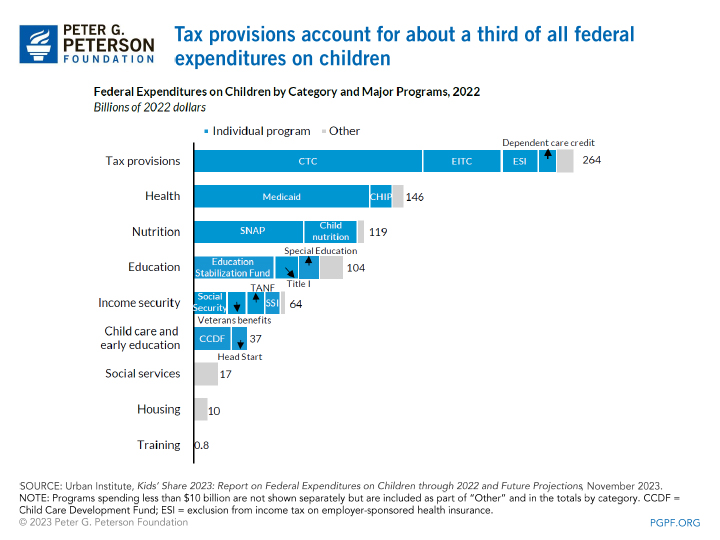
Only 10 Percent of Federal Outlays Goes Toward Children
Federal spending on children (which excludes tax reductions) totaled $609 billion in 2022, or 10 percent of the federal budget. In comparison, 39 percent of outlays went towards health and retirement benefits for adults 18 years of age and older, 12 percent went towards defense spending, and 8 percent went to interest on the federal debt.
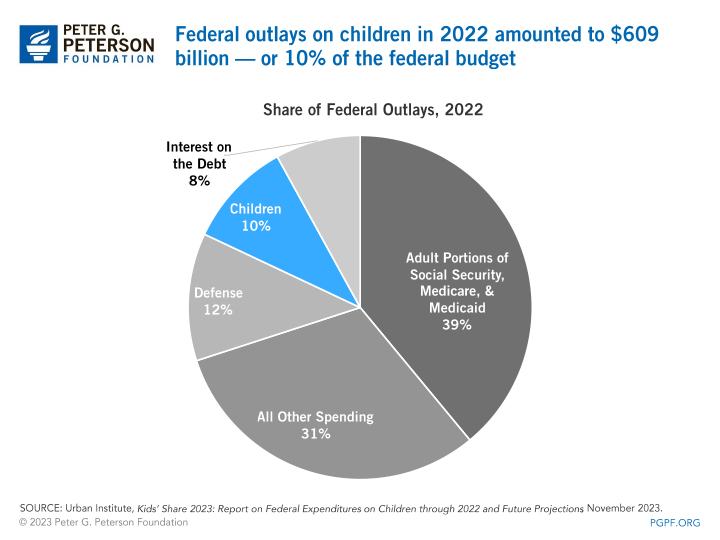
As COVID-19 Relief Expires, Child Poverty Has Increased
As a result of the expanded federal aid provided to children from pandemic relief, child poverty fell in 2020 and 2021 according to the supplemental poverty measure (SPM), which accounts for government programs designed to assist low-income families. Child poverty dropped from 12.5 percent in 2019 to 9.7 percent in 2020 and 5.2 percent in 2021. However, as federal aid for children waned, child poverty increased to pre-pandemic levels in 2022. Poverty rates for adults also fell during the pandemic but to a lesser extent.
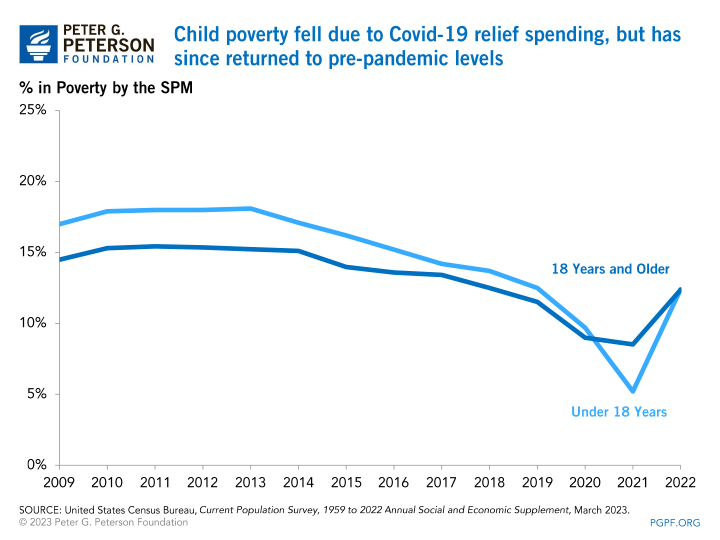
Federal Spending on Children is Projected to Decline as a Share of the Budget
Since the early 2000s, federal spending on children as a portion of the budget has been around 10 percent. However, that share is projected to decline significantly over the next decade from 9.8 percent in 2022 to 6.2 percent by 2033: a 37 percent decline in the share of the budget devoted to children. The largest share of federal spending will continue to go towards the adult portions of Social Security, Medicare, and Medicaid — with such spending in those programs set to increase from 39 percent in 2022 to 48 percent by 2033.
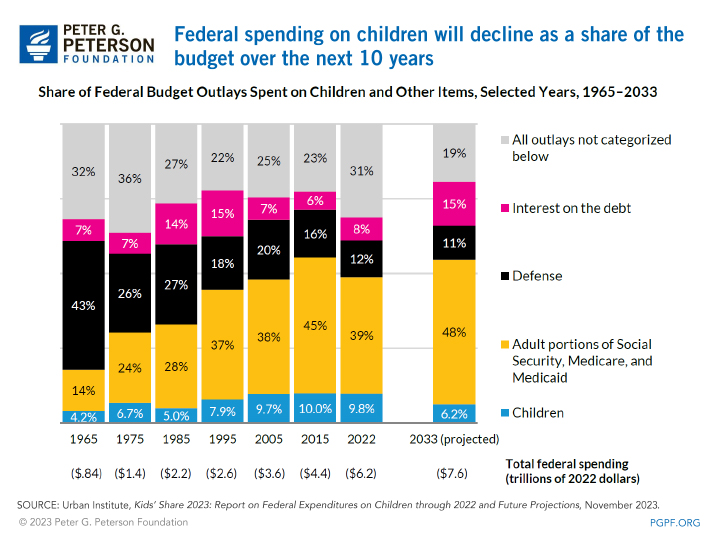
In the Coming Years, We Will Spend More on Interest Payments on the National Debt than on Children
One of the most damaging effects of rising debt is growing interest costs, which makes it harder to invest in our nation’s future. In 2022, spending on interest payments totaled $476 billion — nearly two-thirds the amount of federal spending on children. However, interest costs are expected to rapidly outpace spending on children in the next 10 years.
By 2033, the Congressional Budget Office projects that interest costs will increase to $1.4 trillion. That growth would crowd out spending on other national priorities including America’s children. The federal budget is a statement of the nation’s priorities, and the United States is on track to spend more on net interest costs than the next generation.
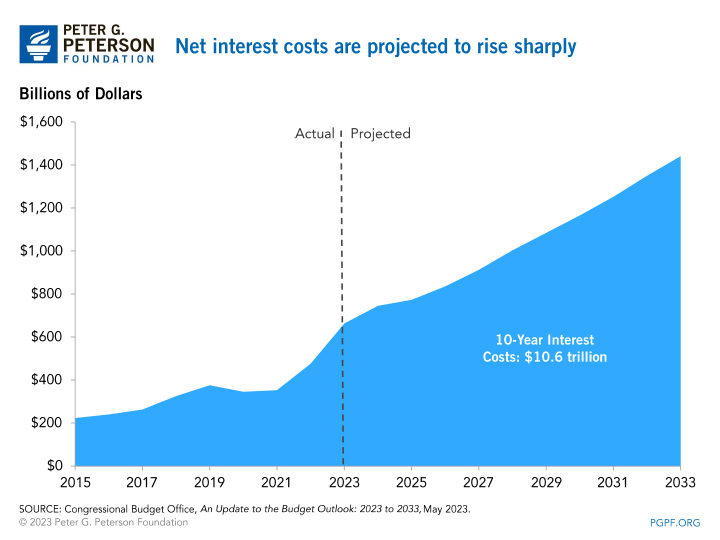
Conclusion
Government resources dedicated to children was bolstered by pandemic relief aid, but as that relief waned, federal expenditures on children decreased in 2022. In the coming years, the share of the federal budget devoted to children is projected to further decline. As the nation’s fiscal outlook continues on its unsustainable path, it is important that policymakers understand the way debt, deficits, and interest costs affect the federal government’s ability to invest in priorities, including the nation’s children.
Related: What Are The Economic Costs of Child Poverty?
Image credit: Karen Ducey/ Getty Images
